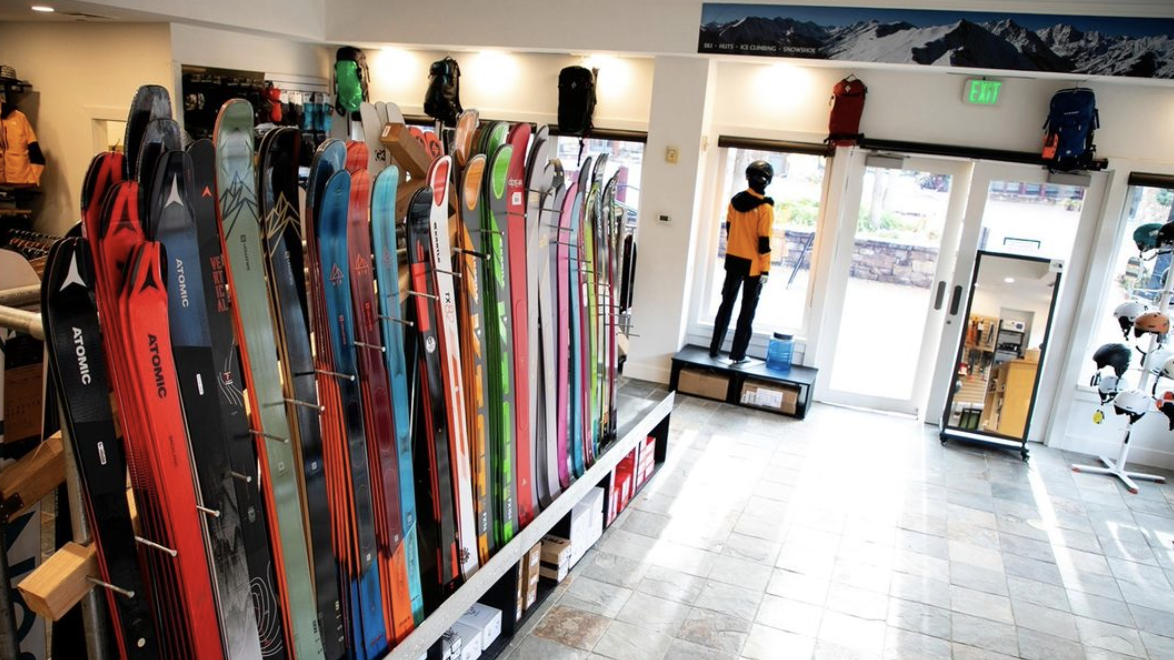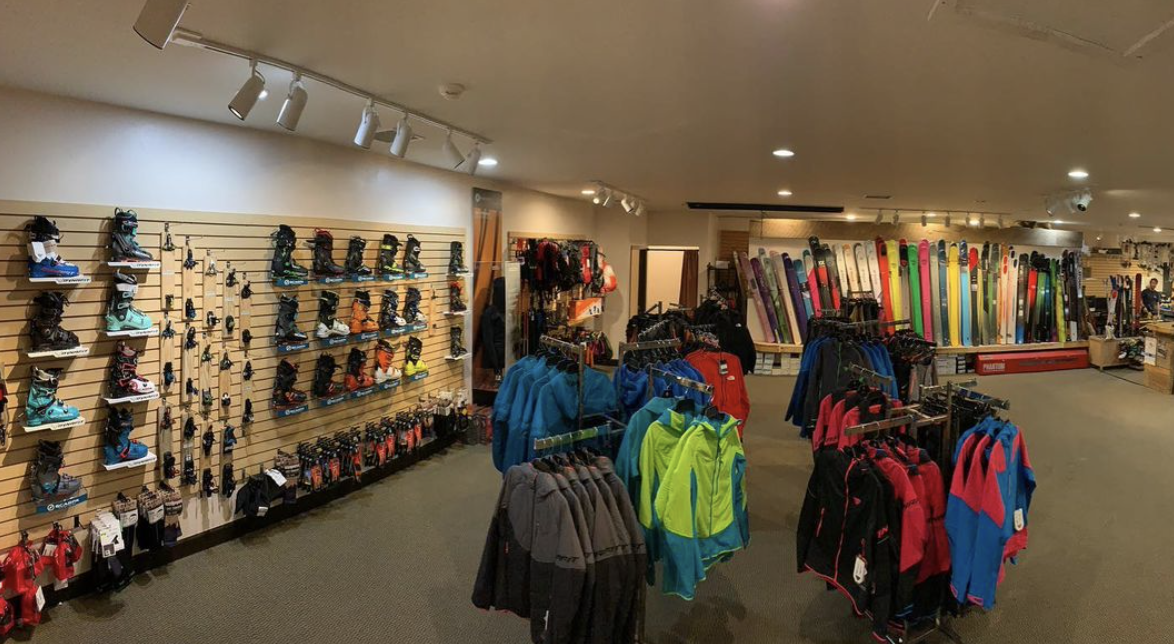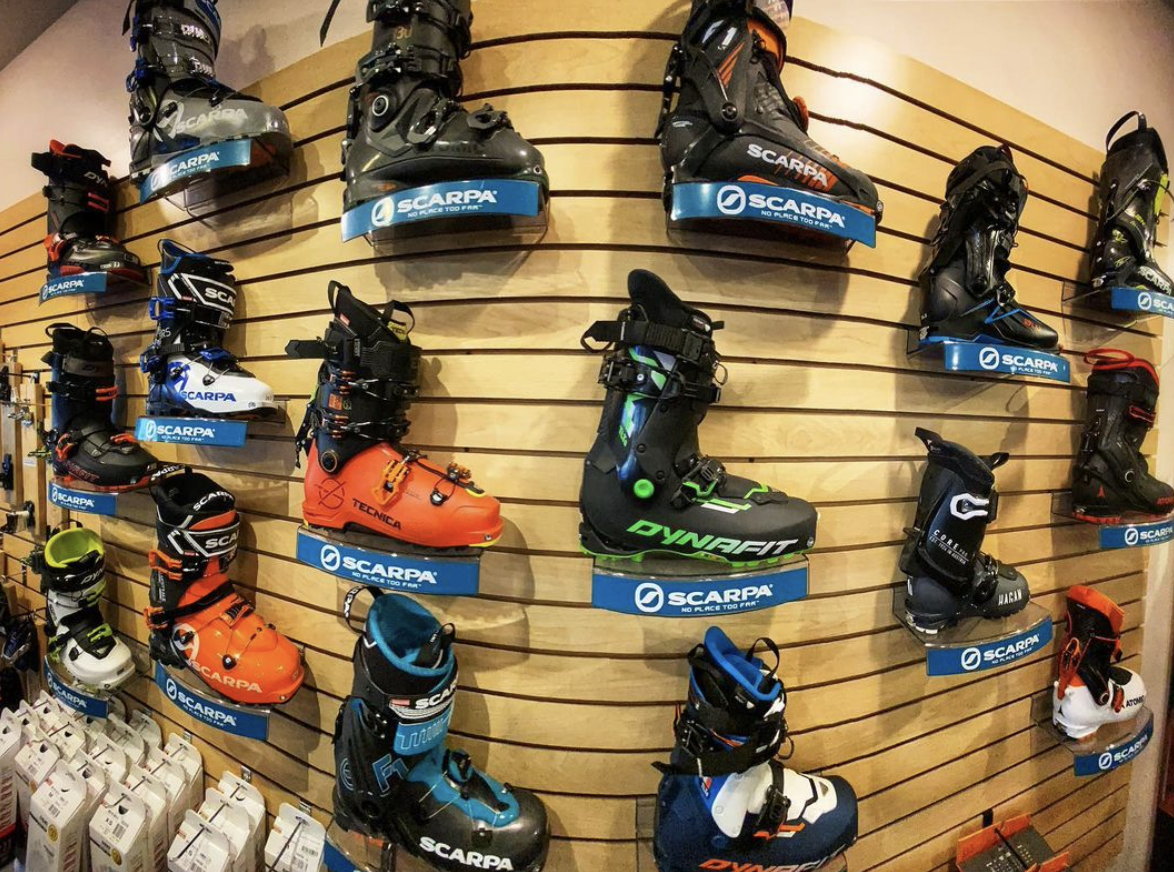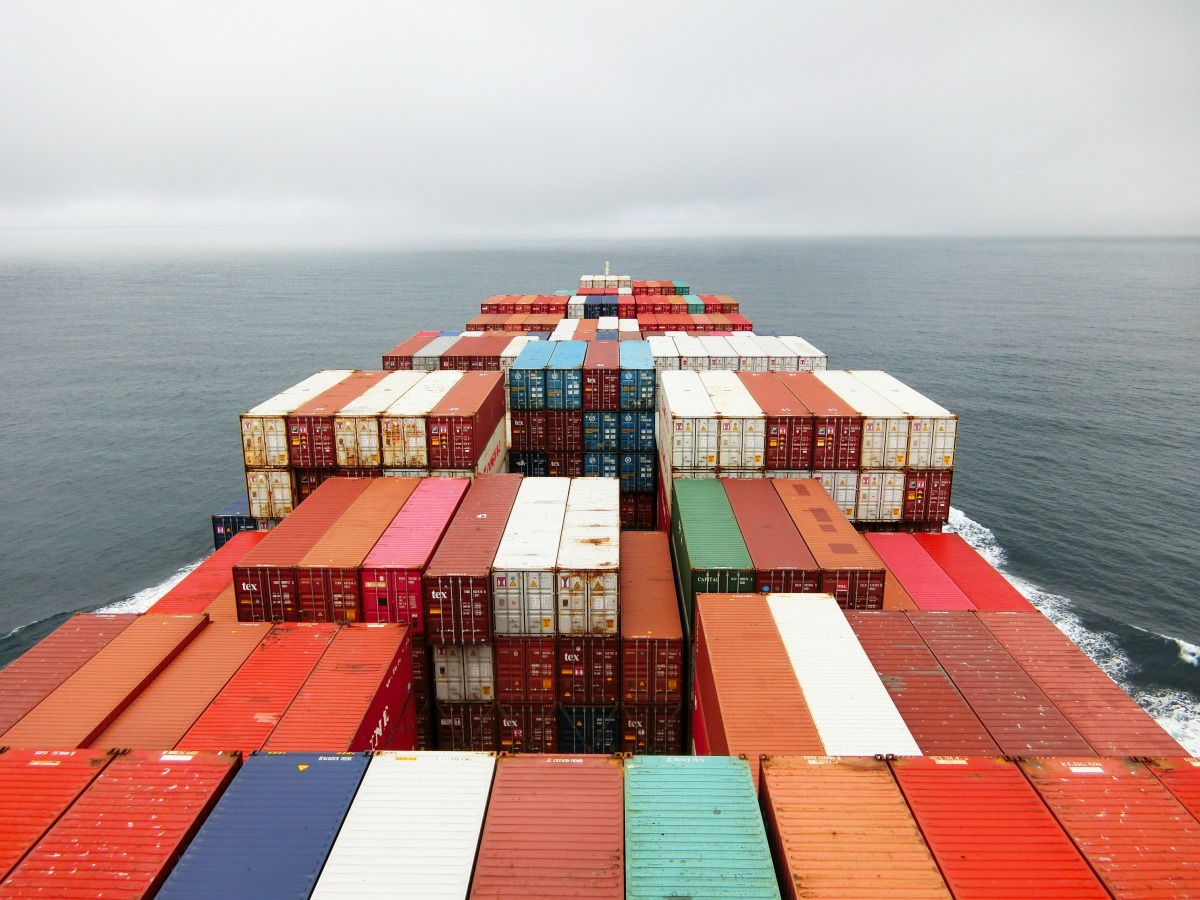
The start of the season should see mostly stocked shelves in ski shops, with hiccups in the supply chain impacting on-time delivery of some products. Photo: @cripplecreekbc
Mountain Outfitters in Breckenridge, Colorado, is the type of brick and mortar glue of any mountain town. They sell the full spectrum of outdoor products, including backcountry ski gear. Doug Bittinger and his wife Cindy Reese bought the store in 2012. Like many small businesses over the last 18 months, their fortunes have ebbed and flowed with Covid related travel restrictions, shutdowns, high demands for outdoor sports gear, and the crosshairs of supply and demand.
As we spoke on the phone a few weeks ago, Bittinger stared at a near gearless wall that typically features backpacks of all sorts. “I probably received 30% of the packs I ordered before the summer season,” said Bittinger. “Right now, on my pack wall, I literally have three packs. And a lot of that is because most packs are made in Vietnam.”
Although Vietnam is not associated with backcountry skiing hard goods, it is a timely example of the tenuous global supply chain. With Covid numbers up in the country, a website monitoring the fashion industry reported one-third of Vietnam’s textile and garment factories closed in mid-August. What happens in places like Vietnam directly impacts livelihoods in Breckenridge.
Backpack scarcity is a granular illustration of why outdoor sports retailers and manufacturers might be anxious. As ski season approaches, what’s on everyone’s minds in the ski world is will retailers receive products on time and will they receive their complete order?
“These are all things that are just compounding and making me lose sleep at night,” said Bittinger.
A Run on Ski Gear
Imagining the supply chain and process that forms raw materials to lightweight yet damp-skiing powder tools is dizzying. There’s wood, epoxy, metal, carbon fiber, fiberglass, and this mouthful, Ultra High Molecular Weight polyethylene, incorporated into the ski’s design. Then there’s the crafting of the ski and the shipping of the ski to its intended market. Shipping and delivery involve small delivery vehicles, semi-trucks, container ships, and air cargo.
If this well-oiled machine hums, we get to covet new skis at the shop. The shop sells those skis. We ski. And hopefully, we smile. But as of summer 2020, that efficient and once relatively seamless chain of events had been monkey wrenched.
The winter of 2020-2021 was the first entire winter season experienced during the pandemic. (Covid protocols and closures were enacted in North America starting March 2020.) In the build-up to the ski season, signs pointed to a run on gear similar to the bike industry, and those prognostications came true.

Before the boom in backcountry skiing, most stores were well stocked. Photo: @cripplecreekbc
“We asked a lot of our customers — which is the same thing that bike sellers have been asking their customers — to basically have some flexibility”, said Doug Stenclik, co-owner of Colorado-based Cripple Creek Backcountry.
“But, we had really good luck last winter, even with the surging demand to get everybody that needed to be on skis on skis,” Stenclik said. But, flexibility on the part of the customer and retailer took the form of maybe not getting your dream binding but settling for another binding in the same class that would work.
One difference Stenclik noted that made gear available in some ski shops compared to the relative scarcity for bike retailers was Cripple Creek’s broad in-store brand representation. Many bike shops lead with two to three or possibly four brands.
“If those brands are too narrow, they’re done,” said Stenclik. “For us, because we kind of carry everything for ski touring, we would disappear a Scarpa boot because it was low stock, and we could replace it with, say, a Salomon boot, so we never got to that point. But it took some pretty aggressive maneuvering.”
Bittinger of Breckenridge’s Mountain Outfitters had a slightly different experience with supply. Despite being shut down for seven weeks as the pandemic began, Bittinger said the store had a record year, due primarily to its high sales during the fourth quarter from October 1 through December 31. The downside to his fourth-quarter uptick were bare shelves. “We brought in as much [ski] product as we could afford to bring in,” Bittinger said. “By the time we got to January, we had no product left.”
Forecasting for Winter 2021-2022
From a retail perspective, the encouraging word from Europe is that most products will arrive on time. But, unknowns remain for retailers as the supply chain bottlenecks persist. For complex reasons, there are labor shortages, and raw materials are tough to come by. And the global shipping flow is bogged down and more costly.
Bittinger plans for a soft landing this winter if there’s a renewed surge in demand for backcountry ski goods. He says last season’s newcomers might have lost the infatuation and may flood the resale market. He based his 2021-2022 preseason orders on his gear-buy for the 2019-2020 season. To keep our timeline straight, that’s pre-Covid.
Stenclik said his group placed orders for gear as soon as possible, asking for an August delivery, with the understanding they would have a buffer if goods arrived in October. Cripple Creek’s strategy also relies on buys with many brands. “We just try to spread our buys out over a wider variety and not go as deep into some of our favorite brands as we would have under normal circumstances, just to give us some added flexibility.”
European based Dynafit is Cripple Creek’s largest supplier. Stenclik said he received a spreadsheet from the company detailing which products were on schedule for delivery or running late. Considering Dynafit’s binding offerings, models like the venerable Speed Turn and some S T Rotations are slated for delays. According to both Stenclik and Bittinger, those models are still top sellers. Dynafit boot delivery dates are varied, with most models and sizes arriving well before sufficient snow falls. If you are looking for a specific make, model, and size, check with a retailer to determine an ETA.
And those looking for a BCA beacon or shovel will have to play the waiting game too. Those product shipments are delayed. The same is true for more minimalist bindings from Salomon and Atomic. Roughly two weeks ago, Amer Sports, the Salomon and Atomic parent company, asked retailers receiving a recent production run of MTN or Backland bindings (identical bindings with different branding) to return those items for inspection. According to Stenclik, Amer is not calling this a recall, and the request does not affect past iterations of the MTN or Backland bindings.

Companies like Dynafit expect most boot models to arrive in the U.S. on time. Photo: @cripplecreekbc
Navigating the Supply Chain
The scene in Europe, where most premium backcountry ski products originate, illustrates why those of us scrambling for a specific set-up in the U.S. should practice patience. Ross Herr, U.S. sales and marketing director for Oberalp, a European company running a suite of outdoor brands including Dynafit and Pomoca, says supply issues last winter mainly resulted from increased demand.
“We can’t react in November,” Herr said. “Every retailer in the country under-forecasted the demand last winter. What happens is we just have to ride that one out. We were sold out in November, and it was definitely unforeseen.”
Fabian Garza, the vice-president of operations at Black Diamond Equipment, echoed Herr in an email. “Last winter, it felt like a bold decision to not reduce our supply plan for Snow product. As the season began, we felt more comfortable and as the season progressed, we saw a surge in demand that exceeded our expectations. Our beacon and skin categories were in highest demand. We focused and energetically reacted or “chased” where possible and clearly communicated to our retail/specialty partners what our available to sell position was throughout the season. Consumer demand maintained through the spring, and we were able to narrow or close the gap of demand in the first few weeks of 2021.”
The global markets have not seen disruption on this scale in generations. The ripple effect has permeated every industry and challenged manufacturers throughout the supply chain.
“Under the circumstances, to both meet growing demand, as well as manage issues with supply chain, you know, call it extortionist level shipping rates, and challenges, everything compounded at an even much higher level over the past 18 months,” said Herr. “It created just sort of the perfect storm in that regard.”
Herr says new Dynafit bindings typically have a lag time of two years, including prototyping and bringing the binding to market. Dynafit forecasts future product supply for its regional markets with tempered growth in mind. According to Herr, before Covid, Dynafit expected demand to grow organically, and they planned for a modest increase in production.
Now, like many companies, Dynafit’s baseline inventory struggles to meet demand.
“A production lot that would have satisfied X, Y, Z markets in a sufficient period of time is now only satisfying one market at a time,” said Herr. “When this first batch of a product is ready, we’re going to give X percentage to the European market, X percentage to the North American market, and sort of divvy it out. So, the product is coming in more staggered batches, as opposed to the larger lump sums to satisfy each market at a time. It has slowed things down in the sense that we won’t get our whole season’s inventory in one delivery.”
The outlook for Pomoca skins, also in Herr’s portfolio, is glass-half-full. Herr says a second factory to produce skins in Switzerland has come online to help build inventory.
Pomoca’s skin line relies heavily on Mohair – a natural fiber made from Angora goat hair. The brand sets high standards for animal care and fiber quality. “We have a really strict supply chain requirement with Pomoca,” said Herr. “That limits how many suppliers you can work with, but that’s the right choice for us.” Still, when thinking of skins this season, Herr says to plan ahead. Currently, just a few manufacturers of high-quality skins supply the marketplace.
In terms of skis, Dynafit experienced a few hiccups of note. There’s an upside, though, Dynafit will release a new series of freeride skis, the Free 97 and 107, earlier than expected.
Dynafit had sourced their freeride skis, known as the Beast, from a massive Fischer factory in Ukraine. The factory burned to the ground in October 2002, destroying the Beast molds. The company pivoted and released a new freeride line this season as a Beast replacement ahead of schedule.
The Fischer factory fire was but one seemingly random snafu. But across the last 18 months, logjams have become the norm. Black Diamond’s Garza highlights the issues for companies like his that source raw materials and produce products across the globe.
“We have continued to navigate a landscape of shifting constraints. Manpower (factory capacity), materials, and logistics have all seen challenges,” says Garza. “Today our biggest hurdle is the time associated in moving goods globally. There is a general inventory rebuilding cycle taking place and this is stretching available resources thin. Today, this is especially applicable to the shipping and transportation industry.”

According to several shipping forecasters, delays are now the norm. Shipping costs have also increased nearly 300% compared to the same period last year. Photo: Rinson-Chory.
The Shipping Crux
According to Sea-Intelligence, a group providing data analysis to the global shipping industry, the average delay for “late vessel” arrivals was seven days in July. That same month, the reliability of the shipping schedule ran at roughly 35%. By comparison, the average shipping delay in July 2018 was 3.5 days, while the schedule reliability was 75%. It’s a topsy-turvy shipping industry, and few shipments leave the port of origin as scheduled.
Then there’s the cost of shipping goods. Drewry, another shipping industry analyst, paints a grim picture. A current index for the cost of shipping a 40 ft. container has increased 309% compared to the same time last year.
(For now, while exploring online prices for ski gear, the increase in shipping costs appears not to have been passed on to the consumer.)
Dynafit, aware that their window to sell ski gear aligns with snowfall, have promised retailers to forego shipping some delayed goods via container ship and will expedite delivery by shipping via air. Shipping by air cuts roughly 45 days off of the expected shipping time. Even still, the best estimate for the Dynafit air-freighted product is a post-New Year’s arrival in the U.S. market. That said, the majority of Dynafit’s product is on schedule for fall delivery.
Garza at Black Diamond says much of their winter-specific goods should arrive in the U.S. market on time. “With only a few exceptions, most of our Snow product is in D.C. or enroute,” he communicated. “The few exceptions will be delivered later in season and as always, we prioritize communicating expectations to our retail and specialty partners during this dynamic time.”
We imagined, pre-pandemic, the supply chain as linear; in reality, it isn’t. It’s a complex series of inputs and outputs. The contingencies retailers and manufacturers had in place have been overwhelmed by a convergence of unforeseen events.
It’s a worthwhile reminder; people like Bittinger back in Breckenridge are losing sleep as he ponders how he will stock shelves. And undoubtedly, suppliers have accelerated their aging process as they contend with an unwieldy and volatile situation.
There will be powder days, and there will be spring corn missions. If your ski dreams rely on new gear and specific new gear, it’s better to have a contingency in place. Plan ahead, and maybe, if you’ve got the funds, buy early.
Jason Albert comes to WildSnow from Bend, Oregon. After growing up on the East Coast, he migrated from Montana to Colorado and settled in Oregon. Simple pleasures are quiet and long days touring. His gray hair might stem from his first Grand Traverse in 2000 when rented leather boots and 210cm skis were not the speed weapons he had hoped for. Jason survived the transition from free-heel kool-aid drinker to faster and lighter (think AT), and safer, are better.
